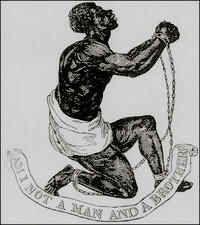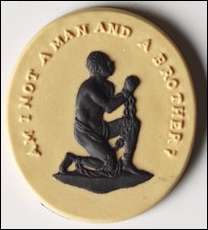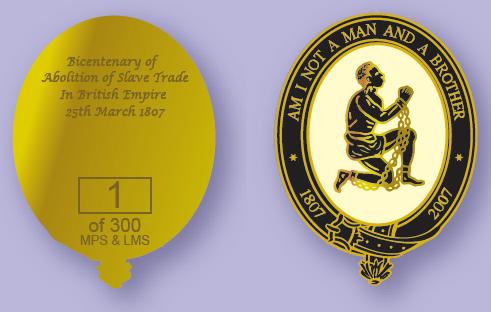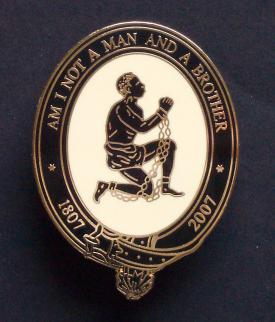Abolition of Slave
Trade - Bicentenary Commemorative Badge
In 1787 Granville Sharp and Thomas Clarkson decided to form
the Society for the Abolition of the Slave Trade. Influential figures such as
William Wilberforce, John Wesley and Josiah Wedgwood also gave
their full support to the campaign and were instrumental in promoting the
Society's cause in both parliamentary and public circles.
In 1807 the society won its battle with Parliament passing of the “Abolition of the Slave Trade Act”.
This act made it illegal to traffic slaves within the British Empire. The act
was largely enforced by the Royal Navy.
Josiah Wedgwood's most
important contribution to the movement for the abolition of slavery was the
production of his "Slave Medallion". These mainly black and white jasper ware
medallions were modelled by William Hackwood at Wedgwood's Etruria Pottery in
Staffordshire. Their central design depicted the emblem and motto of the Society
for the Abolition of Slavery and is a good demonstration of how Wedgwood was
able to adapt his craft for political function.
|
 |
 |
|
A wood cut print commissioned by Josiah Wedgewood in
1792 to adorn the cover of campaigning pamphlets issued by
the Society for the Abolition of the Slave Trade. |
One of the jasper ware medallions produced by Josiah
Wedgewood to publicise the cause of the Society for the Abolition of the
Slave Trade. |
From 1878 these medallions
were distributed in great quantity, primarily to adorn fashion accessories. In
being so worn the medallions publicised the suffering of slaves and hence
were instrumental in turning popular feeling in favour of the anti-slavery
movement. Following the adaptation of the medallion to adorn snuff boxes, hat
pins and brooches, Thomas Clarkson remarked;
"Fashion, which usually
confines itself to worthless things was seen for once in the honourable office
of promoting the cause of justice, humanity and freedom".
Wedgwood sent a large number
of the medallions to Benjamin Franklin in Philadelphia who also remarked on
their value as a means of bringing awareness of the existence of slavery to the
public. Franklin was particularly interested in the art of pottery and his
appreciation of Wedgwood’s art is seen from his reply to Josiah on receipt of
the gift of slave medallions. He writes;
"I am distributing your
valuable present of cameos among my friends in whose countenances I have seen
such marks of being affected by contemplating the figure of the Suppliant (which
is admirably executed) that I am persuaded it may have an effect equal to that
of the best written pamphlet in procuring honour to those oppressed people".
Historical Foot Note:
The Abolition of the Slave Trade Act of 1807 didn't address the plight of
those men, women and children were already sold into slavery throughout
Britain's dominions. This prompted Sharp, Thomas Clarkson and Thomas Fowell Buxton to form the Society for the
Mitigation and Gradual Abolition of Slavery. In 1823 a new Anti-Slavery Society was formed
whose members included Thomas Clarkson,
Henry Brougham, William Wilberforce, and Thomas Fowell Buxton. Two years later,
women such as Elizabeth Pease, Anne Knight, Elizabeth Heyrick and Mary Lloyd
began forming women's Anti-Slavery Societies. As a result of the campaigning of
several of these women's groups between 1827 and 30 the national society dropped the words
"gradual abolition" from its title and agreed to support Sarah Wedgwood's plan
for a new campaign to bring about immediate abolition. The Society finally won
its fight in 1833 with Parliament passing the “Abolition of Slavery
Act”. This finally gave all slaves in the British Empire their freedom.
The Bicentenary Commemorative Badge
The
inspiration for our commemorative badge to mark the bicentenary of the passing
of the Abolition of the Slave Trade Act of 1807 is taken directly from
Wedgwood's medallions. The badge's ornate belt border being based upon a
contemporary engraving by the well-known artist Thomas Bewick.
|
 |
 |
|
(Artists impression of both obverse and reverse sides) |
Obverse image of actual badge |
Badge Description & Specifications
Badge Type: High quality hard enamelled
badge complete with brooch pin attachment.
Size: 36 mm tall by 28 mm wide.
Colour: Cream, black and polished gold..
Obverse: See above artists illustration.
Central depiction of negro slave kneeling in chains. Legend around outer
decorated belt border reads ٭ AM I NOT A
MAN AND A BROTHER ٭ plus the dates 1807 and
2007.
Reverse:
Engraved on the reverse in four lines the legend "Bicentenary of
/ Abolition of Slave Trade / In British Empire / 25th March 1807" plus a unique stamped issue number out of a
stated total of 300 making each badge unique. Badge makers marks
in exergue. Only 300 badges are to be made making them a very sort after limited
collectors edition.
Price: £4.00 plus postage and packaging
(see options below).
Each badge is dispatched by first class post with a Royal Mail proof of posting
certificate. See below for postage options and rates.
Availability: 20th
mid April 2007.
Overseas and other Postage & Packing Options
Posting and packaging within the Great Britain &
Northern Ireland are available at the
following rates;
-
First Class Delivery - £0.80
-
First Class Recorded Delivery - £1.50
-
Special Delivery (Insured) - £5.00 (Recommended for larger orders
over 8 badges in size).
Outside of the Great Britain & Northern Ireland;
Mailing option is at buyers choice. The seller can not take
responsibility for any losses in the postal system.
To avoid any disappointment reserve your badge first by e-mail then send payment in the form of postal orders or a personal cheque made out
in Pounds Sterling to;
Linda Smith
2, Mill Terrace, Thorpe Thewles, Stockton-on-Tees, Cleveland. TS21 3JS.
United Kingdom
Badges will be despatched immediately on clearance of payment.
To reserve your badge e-mail:
linda.smith64@virgin.net or
telephone UK (0)1740 630014.
We can accept secure on-line payments via Paypal sent to us on the above e-mail
address. However, on orders of 5 badges or under we would request customers
pay an additional sum of £0.50 per order to cover PayPal's handling charges.

View More Badges Home Page
Contact Us About Us




